| CHEVROLET CAMARO History
Introduction: After
two years of watching the Ford Mustang enjoy tremendous success, General
Motors finally launched its entry into the pony car segment, the Chevrolet
Camaro. Named after the French word for "comrade," some linguists argued
that it was actually Spanish for a type of shrimp. Not exactly an awe aspiring
name for a new pony car. From the beginning, however, no one could argue
its intentions. Although available with a mediocre six cylinder for volume
sales, the Camaro could be equipped with several V8s and a myriad of performance
options. Then, of course, was the famous Regular Production Code, Z/28,
that would change the industry's view of pony cars.
1967 Chevrolet
Camaro
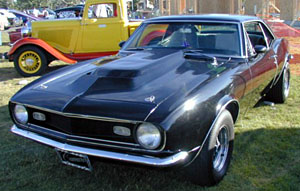 Comments:
The Chevrolet Camaro was introduced with great fanfare. Inital engine choices
included a pair of V6s and a pair of V8s. Available from the start in hardtop
coupe and covertible body styles, the Camaro could be order with nearly
80 factory options and 40 dealer accessories including three main option
packages. The RS package included numerous cosmetic changes including a
blacked out grill with hidden headlights, revised parking and tail lights,
and RS badging. Of greater interest to enthusiasts was the SS package which
included as standard equipment a modified 350 cid V8 with an available
396 cid big block producing 325bhp (L35) and later a 375bhp version, along
with simulated air-intakes on the hood, special bumble bee striping, and
a blacked out grill. It was possible to order both the RS and SS packages,
and get a RS/SS Camaro, in which case the RS badging took precedence. Comments:
The Chevrolet Camaro was introduced with great fanfare. Inital engine choices
included a pair of V6s and a pair of V8s. Available from the start in hardtop
coupe and covertible body styles, the Camaro could be order with nearly
80 factory options and 40 dealer accessories including three main option
packages. The RS package included numerous cosmetic changes including a
blacked out grill with hidden headlights, revised parking and tail lights,
and RS badging. Of greater interest to enthusiasts was the SS package which
included as standard equipment a modified 350 cid V8 with an available
396 cid big block producing 325bhp (L35) and later a 375bhp version, along
with simulated air-intakes on the hood, special bumble bee striping, and
a blacked out grill. It was possible to order both the RS and SS packages,
and get a RS/SS Camaro, in which case the RS badging took precedence.
Chevrolet then quietly released
one of the most famous options codes of all time, option Z-28. Unpublicized
and unknown by most of the buying public (and most Chevrolet sales people
for that matter) and not mentioned in any sales literature, the only way
someone could order the Z-28 package was to order a base Camaro with the
Z-28 option, mandatory front disc brakes with power assist, and the Muncie
4-speed transmission. You could not order the SS package, automatic transmission,
air conditioning, or the convertible. What you got was a unique 302 cid
small block that was created by taking the 327 block and installing the
short-stroke 283 crank. Specificly designed to compete in the Club of America
Trans Am racing series which placed a 305 cid limit on its entries, the
Z-28 was available to the public solely to qualify the car for racing.
Advertised horsepower was listed at just 290bhp, which was not very impressive
until one hooked it up to a dyno and got actual readings of 360-400bhp.
The Z-28 also came with a competition suspension, broad racing stripes
on the hood and trunklid and could be combined with the RS option package.
There was no Z-28 badging at all, lest it attract to much attention. The
Z-28 proved to be difficult to launch on the street because its high reving
engine was lethargic under 4000rpm and worked best when it was shifted
at 7500rpm (!). Once it got going, the Z28 was tough to beat and boosted
a 140mph top speed and numerous racing victories. Only 602 Z-28s were sold
in 1967, making it a truly desireable collectable.
Production: RS: 64,842
SS: 34,411 Z-28: 609
Engines: 230 I6 140bhp.
250 I6 155bhp. (Z-28) 302 V8 290bhp@5800rpm, 290lb-ft@4200rpm. 327 V8 210bhp.
327 V8 275bhp. 350 V8 255bhp. (SS350) 350 V8 295bhp@4800rpm, 380lb-ft@3200rpm.
(SS396) 396 V8 325bhp@4800rpm, 410lb-ft@3200rpm. (SS396) 396 V8 375bhp@5600rpm,
415lb-ft@3600rpm.
Performance: (Z-28)
302/290bhp: 0-60 in 6.9 sec, 1/4 mile in 14.85 sec @ 101mph. (SS396) 396/325bhp:
0-60 in 6.0 sec, 1/4 mile in 14.5 sec @ 99mph.
1968 Chevrolet
Camaro
Comments: The 1968
received minor changes for its second year. 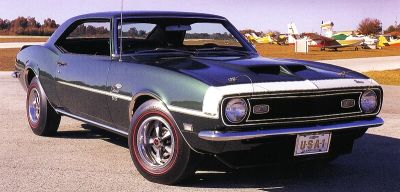 The
grill took on a more horizontal look while the vent windows were dropped
and flow-through ventilation was added. Side marker lights were added while
the SS396 received revised chromed hood inserts (the SS350s stayed with
the 1967 styling). Underneath, the 1967 Camaros pesky axle tramp was cured
by the addition of multi-leaf rear springs to replace the single-leaf units
and rear shock absorbers were now staggered. A new 350bhp 396cid option
for the SS was added, while the Z-28 option actually received some publicity
and sold 7,199 units. The Z-28s were now easier to spot as they sported
Z-28 or 302 badges. The
grill took on a more horizontal look while the vent windows were dropped
and flow-through ventilation was added. Side marker lights were added while
the SS396 received revised chromed hood inserts (the SS350s stayed with
the 1967 styling). Underneath, the 1967 Camaros pesky axle tramp was cured
by the addition of multi-leaf rear springs to replace the single-leaf units
and rear shock absorbers were now staggered. A new 350bhp 396cid option
for the SS was added, while the Z-28 option actually received some publicity
and sold 7,199 units. The Z-28s were now easier to spot as they sported
Z-28 or 302 badges.
Production: RS: 40,977
SS: 27,884 Z-28: 7,199
Engines: 230 I6 140bhp.
250 I6 155bhp. (Z-28) 302 V8 290bhp@5800rpm, 290lb-ft@4200rpm. 327 V8 210bhp.
327 V8 275bhp. 350 V8 255bhp. (SS350) 350 V8 295bhp@4800rpm, 380lb-ft@3200rpm.
(SS396) 396 V8 325bhp@4800rpm, 410lb-ft@3200rpm. (SS396) 396 V8 350bhp@5200rpm,
415lb-ft@3200rpm. (SS396) 396 V8 375bhp@5600rpm, 415lb-ft@3600rpm.
Performance: (SS396)
396/325bhp: 0-60 in 6.6 sec, 1/4 mile in 15.0 sec @ 94mph.
1969 Chevrolet
Camaro
Comments:
1969 saw several noteworthy changes to the Camaro. The grill became deeper
set, the taillamps were longer and thinner and broken into three segments. 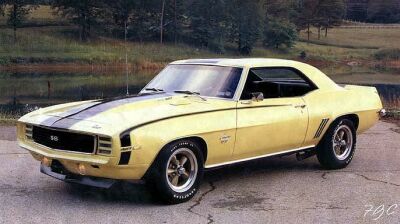 A
heavy "eye-brow" crease was added on the both sides of the car extending
from the front wheel well to the rear wheel well. A matching crease went
from the rear wheel well to the rear quarter panel. Endura rubber bumpers
were available on the Camaro as well as a two ram air induction systems
for the SS. The first was a new special hood with a rear facing inlet and
cold-air duct underneath the hood. The second was a dealer installed cowl
plenum kit that came with a special air cleaner and adapter. No special
hood was needed. The RS package was still popular, and included a special
grill with concealed headlights (of a ribbed design) and washers, chrome
wheel well moldings, drip rails, pinstripes, and RS badging. The SS standard
350 received a slight power boost to 300bhp but the big news was the availability
of special 427 cid equipped Camaros. The first were special dealer-installed
units, most notably the Yenko Camaro 427. Yenko Sports Cars, based in Pennsylvania,
along with other Chevy dealers such as Nickey in Chicago, Dana in California,
and Baldwin-Motion in New York, would install the L72 427 cid block, rated
at 425bhp by Chevrolet, ordered under the Central Office Production Order
System (COPO) code 9562 into a buyer's Camaro. The Yenko Camaro 427 is
a typical example: it came from the factory with no ornamentation, badging,
and the 427 engine in a crate. Yenko installed the 427 block, changed the
rating to a more realistic 450bhp, and added 15-inch rally wheels, bigger
front roll bar, and sYc (Yenko Sports Car) badging. A full complement of
racing add ons were available and sub 13 second quarter miles were possible
with a few more dollars. A
heavy "eye-brow" crease was added on the both sides of the car extending
from the front wheel well to the rear wheel well. A matching crease went
from the rear wheel well to the rear quarter panel. Endura rubber bumpers
were available on the Camaro as well as a two ram air induction systems
for the SS. The first was a new special hood with a rear facing inlet and
cold-air duct underneath the hood. The second was a dealer installed cowl
plenum kit that came with a special air cleaner and adapter. No special
hood was needed. The RS package was still popular, and included a special
grill with concealed headlights (of a ribbed design) and washers, chrome
wheel well moldings, drip rails, pinstripes, and RS badging. The SS standard
350 received a slight power boost to 300bhp but the big news was the availability
of special 427 cid equipped Camaros. The first were special dealer-installed
units, most notably the Yenko Camaro 427. Yenko Sports Cars, based in Pennsylvania,
along with other Chevy dealers such as Nickey in Chicago, Dana in California,
and Baldwin-Motion in New York, would install the L72 427 cid block, rated
at 425bhp by Chevrolet, ordered under the Central Office Production Order
System (COPO) code 9562 into a buyer's Camaro. The Yenko Camaro 427 is
a typical example: it came from the factory with no ornamentation, badging,
and the 427 engine in a crate. Yenko installed the 427 block, changed the
rating to a more realistic 450bhp, and added 15-inch rally wheels, bigger
front roll bar, and sYc (Yenko Sports Car) badging. A full complement of
racing add ons were available and sub 13 second quarter miles were possible
with a few more dollars.
Overshadowing these dealer
modified Camaros was the factory Camaro ZL1. Specially designed to compete
in the NHRA Super Stock drag classes, Chevrolet made it an option under
the COPO system (code 9560). The cars began as SS396/375bhp Camaros with
the F41 suspension. The SS trim and engine were deleted, and the 427 engine,
cowl-induction hood, front disc brakes, a choice of heavy duty 4 speed
transmissions or Turbo Hydra-matic, and a 4:10 posi axle were added. But
instead of the regular iron-block and head L72 found in the dealer installed
Camaros, the ZL1 sported aluminum heads and the first aluminum block ever
made by Chevrolet. It shared the L88 aluminum head/iron block's engine
rating of 430bhp but made closer to 500bhp -- making it probably the most
powerful engine Chevrolet ever offered to the public. And the engine weighed
just 500 pounds, the same as Chevy's 327 small block. The car was blessed
with a 5 year/50,000 mile warranty and was fully street legal. With factory
exhausts and tires, it turned low 13s; with headers and slicks, it could
turn 11.6s @ 122mph. This was the fastest car ever produced by Chevrolet.
Performance had its price -- ,160 for the ZL1 engine alone pushing the
price of the Camaro ZL1 to an unbelieveable ,200 (about double the price
for a SS396 Camaro). Chevy needed to build 50 to qualify the car for racing,
and in the end built 69 Camaros and 2 Corvettes with the ZL-1 engine. Their
high price made them difficult to sell and at least 12 engines were removed
and about 30 cars were returned back to Chevrolet. It took until the early
1970s to sell them all. One can only wonder what they are worth today.
Production: RS: 37,773
SS: 33,980 Z-28: 19,014
Engines: 250 I6 155bhp.
(Z28) 302 V8 290bhp@5800rpm, 290lb-ft@4200rpm. 327 V8 210bhp. 327 V8 275bhp.
350 V8 255bhp. (SS350) 350 V8 300bhp@4800rpm, 380lb-ft@3200rpm. (SS396)
396 V8 325bhp@4800rpm, 410lb-ft@3200rpm. (SS396) 396 V8 350bhp@5200rpm,
415lb-ft@3200rpm. (SS396) 396 V8 375bhp@5600rpm, 415lb-ft@3600rpm. (COPO
9561) 427 V8 425bhp@5600rpm, 460lb-ft@4000rpm. (COPO 9560) 427 V8 430bhp@5200rpm,
450lb-ft@4400rpm.
Performance: (Z-28)
302/290bhp: 0-60 in 7.4 sec, 1/4 mile in 15.12 sec @ 94.8mph. (SS396) 396/375bhp:
0-60 in 6.8 sec, 1/4 mile in 14.7 sec @ 98.7mph. (COPO 9561) 427/425bhp:
0-60 in 5.4 sec, 1/4 mile in 13.5 sec @ 102mph. (COPO 9560) 427/430bhp:
0-60 in 5.3 sec, 1/4 mile in 13.16 sec @ 110 mph.
1970 Chevrolet
Camaro
Comments: Production
of the 1969 Camaros continued into the beginning of 1970 as the all new
1970 Camaros were not released until mid 1970. 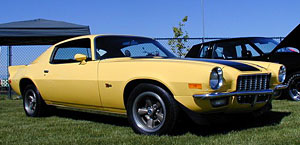 Despite
ominous predictions of the collapse of the pony car market, the new Camaro
was released with much fanfare and much success. Most of the credit went
to the new styling, which was European-inspired and would prove so popular
that it would last until 1982. The new Camaro was two inches longer and
had five inch longer doors. It had better noise insultation. Under the
hood, the proposed new 454 blocks never made it and the Camaro SS continued
with the 350 and 396 engines. After January 1970, however, the 396 engines
no longer displaced 396 cubic inches. Chevrolet actually enlarged them
to 402 cubic inches but the executives decided to name it the 396 to take
advantage of the name recognition and avoid any attention from insurance
carriers. The RS option now included a free standing grill, twin bumperetes,
an Endura rubber grill frame, and parking lights between the headlights
and the grill. The SS option included a special black grill, hidden wipers,
power brakes, engine trim, white-letter tires, chrome dual exhausts, and
the SS396 also came with black-painted trunk panels and a special suspension.
The Z28 saw the most radical change -- an all new 350 cid engine know as
the LT-1 350. It was rated at 360bhp (it had a rating of 370bhp when installed
in Corvettes). This engine proved much more tractable, reliable, and generally
outperformed the 302 engine of old. Despite
ominous predictions of the collapse of the pony car market, the new Camaro
was released with much fanfare and much success. Most of the credit went
to the new styling, which was European-inspired and would prove so popular
that it would last until 1982. The new Camaro was two inches longer and
had five inch longer doors. It had better noise insultation. Under the
hood, the proposed new 454 blocks never made it and the Camaro SS continued
with the 350 and 396 engines. After January 1970, however, the 396 engines
no longer displaced 396 cubic inches. Chevrolet actually enlarged them
to 402 cubic inches but the executives decided to name it the 396 to take
advantage of the name recognition and avoid any attention from insurance
carriers. The RS option now included a free standing grill, twin bumperetes,
an Endura rubber grill frame, and parking lights between the headlights
and the grill. The SS option included a special black grill, hidden wipers,
power brakes, engine trim, white-letter tires, chrome dual exhausts, and
the SS396 also came with black-painted trunk panels and a special suspension.
The Z28 saw the most radical change -- an all new 350 cid engine know as
the LT-1 350. It was rated at 360bhp (it had a rating of 370bhp when installed
in Corvettes). This engine proved much more tractable, reliable, and generally
outperformed the 302 engine of old.
Production: RS: 27,136
SS: 12,476 Z-28: 7,733
Engines: 250 I6 155bhp.
307 V8 200bhp. 350 V8 250bhp. (SS) 350 V8 300bhp@4800rpm, 380lb-ft@3200rpm.
(Z28) 350 V8 360bhp@6000rpm, 380lb-ft@4000rpm. (SS396) 402 V8 325bhp@4800rpm,
410lb-ft@3200rpm. (SS396) 402 V8 350bhp@5200rpm, 415lb-ft@3400rpm. (SS396)
402 V8 375bhp@5600rpm, 415lb-ft@3600rpm.
Performance: (Z-28)
350/360bhp: 0-60 in 6.1 sec, 1/4 mile in 14.4 sec @ 99.1mph.
1971 Chevrolet
Camaro
Comments: On the outside,
the 1971 Camaro differed from the 1970 model mainly with the change to
a high back seat with integrated headrest design. 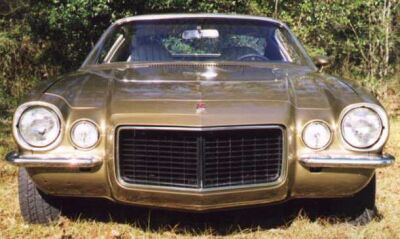 Under
the hood, however, there were big changes. General Motors had decreed that
all its cars for 1971 had to run on unleaded gasoline and this meant a
drop in compression ratios and a big drop in power ratings. The Z-28 saw
its 350 cid engine drop from 11:1 compression to 9:1 (which was still above
the GM mandate of 8.5:1 but GM let it slide) and horsepower dropped to
330bhp from 360bhp. A new three piece rear spoiler for the Z-28 didn't
quite make up for the decrease in performance. Both the SS350 and SS396
(still with a 402 cid engine) saw decreases in power ratings and a proposed
400 cid engine never saw production. The RS package was still available
with corresponding trim and appearance changes. Under
the hood, however, there were big changes. General Motors had decreed that
all its cars for 1971 had to run on unleaded gasoline and this meant a
drop in compression ratios and a big drop in power ratings. The Z-28 saw
its 350 cid engine drop from 11:1 compression to 9:1 (which was still above
the GM mandate of 8.5:1 but GM let it slide) and horsepower dropped to
330bhp from 360bhp. A new three piece rear spoiler for the Z-28 didn't
quite make up for the decrease in performance. Both the SS350 and SS396
(still with a 402 cid engine) saw decreases in power ratings and a proposed
400 cid engine never saw production. The RS package was still available
with corresponding trim and appearance changes.
Production: RS: 18,404
SS: 8,377 Z-28: 4,862
Engines: (SS) 350
V8 270bhp@4800rpm, 360lb-ft@3200rpm. (Z28) 350 V8 330bhp@5600rpm, 360lb-ft@4000rpm.
(SS396) 402 V8 300bhp@4800rpm, 400lb-ft@3200rpm.
1972 Chevrolet
Camaro
Comments: A 174 day
strike at the Ohio plant where all Camaros and Firebirds were built severly
limited 1972 model year production. 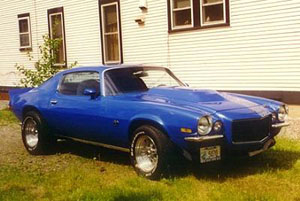 Even
worse, 1,100 unfinished Camaros had to be scrapped because they didn't
meet 1972 federal bumper safety standards. With the declining performance
market, there were many calls to cancel the Camaro. Luckily cooler heads
prevailed and the Camaro stayed in production. Visually, the 1972 Camaros
had a revised grill with only seven vertical slats instead of the previous
12. Another GM mandate required that all power ratings be given in net
terms (including all accessories). Although that led to drastic drops in
peak numbers, the new ratings were actually more accurate than the old
gross power ratings because they were a better reflection of the power
that actually hit the road. Even
worse, 1,100 unfinished Camaros had to be scrapped because they didn't
meet 1972 federal bumper safety standards. With the declining performance
market, there were many calls to cancel the Camaro. Luckily cooler heads
prevailed and the Camaro stayed in production. Visually, the 1972 Camaros
had a revised grill with only seven vertical slats instead of the previous
12. Another GM mandate required that all power ratings be given in net
terms (including all accessories). Although that led to drastic drops in
peak numbers, the new ratings were actually more accurate than the old
gross power ratings because they were a better reflection of the power
that actually hit the road.
Production: RS: 11,364
SS: 6,562 Z-28: 2,575
Engines: (SS) 350
V8 200bhp@4400rpm, 300lb-ft@2800rpm. (Z28) 350 V8 255bhp@5600rpm, 280lb-ft@4000rpm.
(SS396) 402 V8 240bhp@4400rpm, 345lb-ft@3200rpm.
1973 Chevrolet
Camaro
Comments: The big
news for 1973 was the deletion of the SS option, which only left the Z-28
to carry the performance banner. 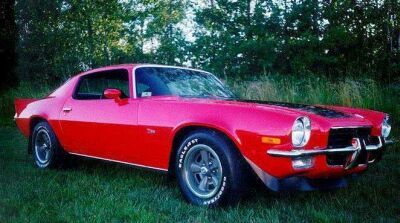 The
RS option remained with revised front bumperettes. A new Type LT option
was added as a luxury package which included a weak V8 and several trim
items. The Z-28 saw another decrease in power as hydraulic lifters replaced
its solid ones. As a sign of the times, air conditioning was available
on the Z-28 for the first time. Despite all this, production for all models
was up. The Chevrolet Camaro would continue, unlike most of its muscle
car era competitiors, in one form or another, until it would return to
its performance roots in the early 1990s. The
RS option remained with revised front bumperettes. A new Type LT option
was added as a luxury package which included a weak V8 and several trim
items. The Z-28 saw another decrease in power as hydraulic lifters replaced
its solid ones. As a sign of the times, air conditioning was available
on the Z-28 for the first time. Despite all this, production for all models
was up. The Chevrolet Camaro would continue, unlike most of its muscle
car era competitiors, in one form or another, until it would return to
its performance roots in the early 1990s.
Production: Z-28:
11,574
Engines: 350 V8 145bhp@4000rpm,
255lb-ft@2400rpm. 350 V8 175bhp@4000rpm, 270lb-ft@2400rpm. (Z-28) 350 V8
245bhp@5200rpm, 280lb-ft@4000rpm.
|